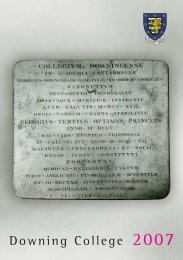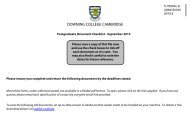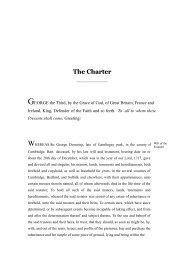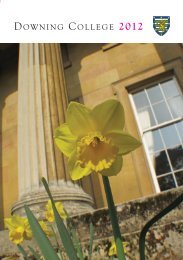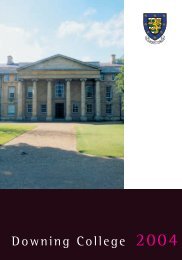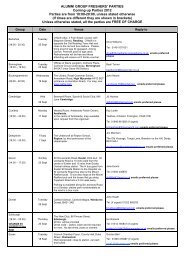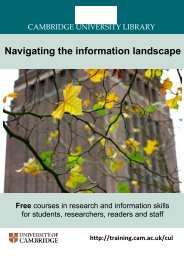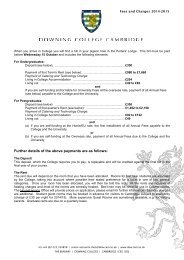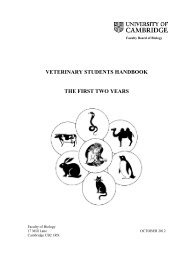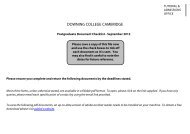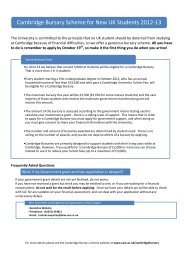Downing 2010 cover opt b_Layout 1 - Downing College - University ...
Downing 2010 cover opt b_Layout 1 - Downing College - University ...
Downing 2010 cover opt b_Layout 1 - Downing College - University ...
- No tags were found...
Create successful ePaper yourself
Turn your PDF publications into a flip-book with our unique Google optimized e-Paper software.
DOWNING COLLEGE 2009–<strong>2010</strong>caused by conflicts in bottom-up processing that the ‘top-down’ systems wererecruited to resolve. He also became interested in how the brain achieved thesefeats, as described in a well-known scientific paper (of about 150 in all) entitled‘The brain as an engineering problem”.He was especially famous for a case study (with Jean Wallace) of the patientSB who had been blind from birth but had received a corneal transplant in 1959.It was thus possible for Gregory to address a venerable paradox posed by Berkeleyabout what it might be like for an individual who had only experienced objectsby touch if their vision was suddenly restored, “Molyneux’ Question”. In fact, asthe two psychologists were able to show by careful testing, SB found visualexperience confusing and was unable to judge distance (tragically he died twoyears later). They were thus able to demonstrate the fundamental role of‘exploratory touch’ in harmony with the development of visual perception, adis<strong>cover</strong>y that inspired him more generally to emphasise the importance of the‘active’ exploration of the world, especially when engaging the public with science.These powerful ideas and demonstrations formed the basis for a remarkablebook, Eye and Brain by Gregory published in 1966, which was an inspiring andentertaining text for undergraduates reading experimental psychology (includingthe present writer), for many years to come. An acknowledged classic in thesubject, it has gone through five editions and been translated into fourteenlanguages. Gregory’s other fifteen books have included a work co-written withErnst Gombrich on Illusion in Nature and Art (1973) and his monumental OxfordCompanion to the Mind (1987;2004) which he edited with great erudition.The other products of Gregory’s fertile imagination were numerousinventions: these included a chromatic photometer, a solid image microscope,a digital printing data recorder, a hearing aid and a telescope camera. He wasconsulted by the Royal Navy to help sailors escape from submarines, by NASAto confront the perceptual problems involved in docking spacecraft, and by thecinema director Roman Polanski for a 3D film that unfortunately for all of usnever saw the light of day.Gregory moved to a Chair in Bionics at Edinburgh in 1967 to pursue hisinterests in machine intelligence, at what was the first centre for the study ofthe subject in the U.K, co-founded with two other luminaries ChristopherLonguet-Higgins and Donald Michie. His ambition was to create a machinethat could “draw interesting analogies and make puns” (the latter being aparticular delight of Richard’s witty conversation).He had moved from Cambridge with his second wife (Freja Balchin) havingdivorced his first spouse (Margaret Muir) with whom had a son and daughter. Hewas then lured to a Chair in Neuropsychology at the Bristol <strong>University</strong> MedicalSchool by (now Sir) Gabriel Horn (recent Master of Sidney Sussex) who was then117



